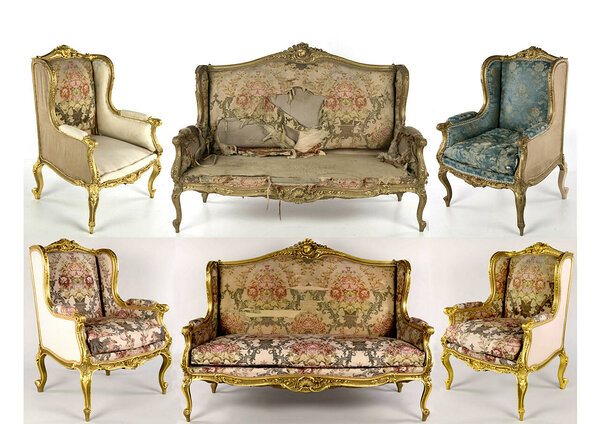The sofa and two armchairs are a part of the Estonian Art Museum’s foreign-made furniture collection and were used during the first period of the Republic in the presidential guest room. By the time the items arrived to be conserved, they had gone through several adventures, which caused the conditions they were in to vary greatly. A large part of the textile covering was missing and the woodcut was greatly damaged. The museum’s wish to restore them in full led to a long and dilemma-ridden undertaking headed by Kanuti conservator Tuuli Trikkant.
The furniture was manufactured between 1876-1900 in Melzer’s Furniture Factory in St. Petersburg, Russia. The set arrived in Estonia during the first period of independence - in the 1930s - when many items had been purchased for Kadriorg Palace from St. Petersburg.
In the 1980s, the armchairs were revitalized. To harmonize the set, they were gilded with a combination of gold leaf and tint.
To conserve the sofa, the structure had to be detached from the pegs. The wood had fractured in several spots, the ornament backrest had broken, and the fabric was torn. The whole structure had to be reglued, restitched, and cleaned. To preserve the integrity of the object, the dents and deficiencies in the wood were remade.
Preserving the fabric is tricky, as it is so fragile. However, the museum aimed to preserve as much of it as possible due to its historical importance.
As the entirety of the original fabric wasn’t able to be conserved, two options were considered. One was to weave in similar fabrics and the other was to reconstruct the fabric, which is a long and complicated task. Negotiations with weaving companies in France and the Czech Republic ensued, with an emphasis on preserving the history of the furniture.
A compromise was made, as a fabric that was extremely similar and minimally affected with existing textile was woven in. The difference is only visible up close. The work with the surviving fabric pattern continues at the Flag Factory after having been digitized.
The long and complex process of conservation and restoration has restored the set and made it possible for them to be exhibited. The background of such objects characterizes Estonia’s history and provides an insight to different conservation methods.
Before and After photos taken by Jaanus Heinla.
The furniture was manufactured between 1876-1900 in Melzer’s Furniture Factory in St. Petersburg, Russia. The set arrived in Estonia during the first period of independence - in the 1930s - when many items had been purchased for Kadriorg Palace from St. Petersburg.
In the 1980s, the armchairs were revitalized. To harmonize the set, they were gilded with a combination of gold leaf and tint.
To conserve the sofa, the structure had to be detached from the pegs. The wood had fractured in several spots, the ornament backrest had broken, and the fabric was torn. The whole structure had to be reglued, restitched, and cleaned. To preserve the integrity of the object, the dents and deficiencies in the wood were remade.
Preserving the fabric is tricky, as it is so fragile. However, the museum aimed to preserve as much of it as possible due to its historical importance.
As the entirety of the original fabric wasn’t able to be conserved, two options were considered. One was to weave in similar fabrics and the other was to reconstruct the fabric, which is a long and complicated task. Negotiations with weaving companies in France and the Czech Republic ensued, with an emphasis on preserving the history of the furniture.
A compromise was made, as a fabric that was extremely similar and minimally affected with existing textile was woven in. The difference is only visible up close. The work with the surviving fabric pattern continues at the Flag Factory after having been digitized.
The long and complex process of conservation and restoration has restored the set and made it possible for them to be exhibited. The background of such objects characterizes Estonia’s history and provides an insight to different conservation methods.
Before and After photos taken by Jaanus Heinla.
